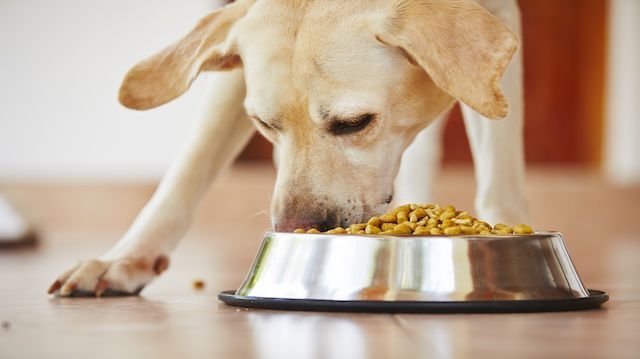
Gluten is the term for proteins found in wheat, rye, barley and oats. It has glue-like properties, allowing food to stay together. Celiac disease occurs in people with a genetic predisposition and results in damage to the small intestine because of gluten sensitivity. It makes digestion difficult for the affected population.
The Celiac Disease Foundation estimates that one in 100 people in the United States have celiac disease. The disease is not found in most dogs, but allergies to wheat and other grains are more common.
Grain-free versus gluten-free
Just because a dog food is gluten-free does not mean it’s grain-free. It just means the food doesn’t contain any wheat, barley, oats or rye. It might still contain soy or corn. If you purchase a grain-free dog food, that generally means it’s also gluten-free. A manufacturer might label a grain-free food as also being gluten-free, but that’s marketing for the uninformed. Dog food that doesn’t contain grains often contains ingredients high in carbohydrates, such as sweet potato or tapioca. It’s always crucial to read the label of any human or pet food if gluten intolerance is an issue.
Affected breeds
Most dogs do not suffer from celiac disease, so a gluten-free diet is not necessary. There is one major exception. Irish setters and dogs with Irish setter ancestry may suffer from hereditary gluten intolerance. It’s not present in the majority of Irish setters, but it does exist.
While any dog may develop wheat-related allergies, some breeds are more predisposed than others. Boston terriers are often allergic to products containing corn or gluten, resulting in skin issues, or atopic dermatitis.
Canine allergies
Even if you feed your dog a grain-free diet, that doesn’t mean he won’t suffer from allergies. Although some dogs are allergic to grains, other ingredients are far more likely to trigger allergic skin reactions. These include beef and dairy products.
Here are the top five dog-food brands that offer gluten-free options that contain ingredients less likely to cause allergies:
Taste Of The Wild
One advantage of Taste Of The Wild is that many of its dry and canned dog food do not contain primary meat proteins that cause allergies. Instead, TOTW uses less common meats, including:
- Bison
- Venison
- Wild boar
- Salmon
There are roast lamb and roast fowl varieties, with the latter consisting of duck and chicken. Depending on the formulation, TOTW products may contain carbohydrates in the form of garbanzo beans and sweet potatoes, along with fruits and vegetables.
Wellness Grain-Free Dog Food
Wellness offers a variety of grain-free wet and dry dog food, including their Core, Simple and Complete Health lines. There are foods designed specifically for puppies and large and small breeds. The Core foods feature recipes including turkey, chicken, fish, wild game and fruits and vegetables. The Simple foods consist of just one protein and one carbohydrate source — an excellent choice for a food-allergy trial. Complete Health includes deboned chicken, lamb and whitefish varieties. The canned foods contain vegetables not often found in other dog foods, such as kale and spinach.
Canidae Grain-Free Pure
Canidae calls its grain-free pure line “simple recipes for sensitive pets.” The primary ingredient is either fresh fish or meat, along with secondary ingredients including:
- Chickpeas
- Lentils
- Sweet potatoes
None of the grain-free recipes contain more than 10 ingredients, and many contain less.
Blue Buffalo Grain-Free Dog Food
Blue Buffalo’s line of grain-free dry dog food consists of 14 products, many based on age, weight and breed size. Meats in the grain-free line include duck, salmon and chicken.
Fromm
Fromm, a family-operated company based in Wisconsin, produces artisanal grain-free dog food geared to the animal’s age and activity level. Game bird, pork, salmon and other meats are featured. The kibble size is smaller than many other brands, making it easier for older canines or those with poor dentition to eat.
Dog-food considerations
Individual dogs will prefer and do better with some foods than others, no matter how highly rated they are. That’s why even the best dog foods will have unsatisfied customers posting poor reviews of a particular item. A dog’s needs vary according to life stage. When you change dog foods, do so over a period of several days. Even the best new food may upset a dog’s digestive system if it’s not given time to adjust.
—Jane Meggitt
Jane Meggitt graduated from New York University and worked as a staff writer for a major New Jersey newspaper chain. Her work on pets, equines and health have appeared in dozens of publications, including The Daily Puppy, The Nest Pets, Horse News, Hoof Beats and Horseback magazines.
Sources:
http://www.petmd.com/dog/centers/nutrition/evr_dg_why-grain-free-dog-food-may-not-be-the-best-choice
https://www.petcarerx.com/article/gluten-and-corn-sensitivity-in-boston-terrier-dogs/298
https://celiac.org/live-gluten-free/glutenfreediet/what-is-gluten
http://heavy.com/pets/2015/03/best-grain-free-healthy-dog-food-brands-reviews
http://www.reviews.com/dog-food/grain-free
http://www.tasteofthewildpetfood.com/#products
http://www.wellnesspetfood.com/dog-wellness.aspx
https://frommfamily.com
http://www.canidae.com/dog-food

